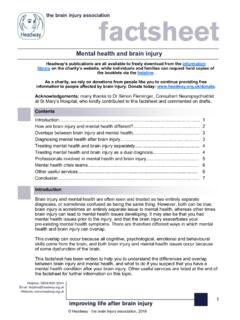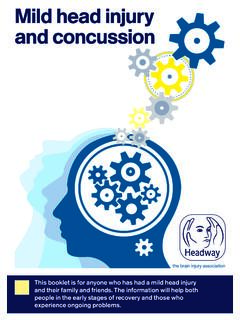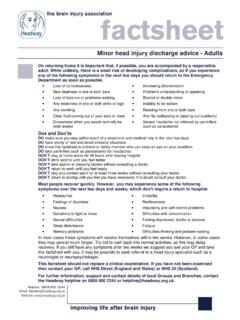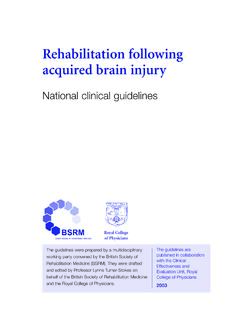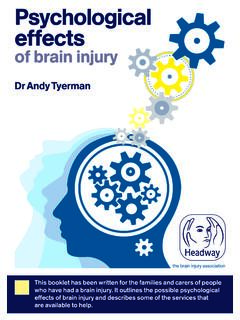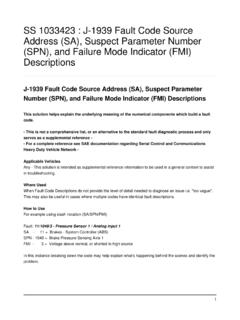Transcription of Hypoxic brain injury - Headway
1 1 Acknowledgements: Many thanks to Dr Steven White, Consultant Neurophysiologist, for co-authoring this factsheet. A Hypoxic brain injury is a type of brain injury that occurs when there is a disruption in supply of oxygen to the brain . A diagnosis of Hypoxic brain injury might not always be obvious, as the circumstances that caused the injury might not directly involve the brain , for example having a heart attack or inhaling smoke. This is especially true if the initial condition is successfully treated and the impact on the brain was relatively mild. This factsheet is intended as an overview of the causes, effects, treatment and rehabilitation of Hypoxic brain injury . The information will be particularly useful for the family members of people who have sustained such an injury . Words in bold are defined in a glossary at the end of the factsheet. To understand what Hypoxic brain injury is, it is important to understand a little bit about how the brain works.
2 The brain relies on a constant supply of oxygen to survive. Indeed, it uses around 20% of the body s total oxygen intake. Oxygen is needed by the brain to sustain chemical processes that ultimately create energy. If the oxygen supply is interrupted, the functioning of the brain is immediately disturbed, and irreversible damage can quickly follow. Consciousness can be lost within 15 seconds, and damage to the brain begins after about four minutes without oxygen. Introduction Hypoxic brain injury What is Hypoxic brain injury ? Headway s publications are all available to freely download from the information library on the charity s website, while individuals and families can request hard copies of the booklets via the helpline. Please help us to continue to provide free information to people affected by brain injury by making a donation at Thank you. Headway - the brain injury association, 2018 This factsheet has kindly been sponsored by: 2 A complete interruption of the supply of oxygen to the brain is referred to as cerebral anoxia - this can cause what is known as anoxic brain injury .
3 Partial oxygen supply interruption is known as cerebral hypoxia and can cause what is known as a Hypoxic brain injury . In practise, these two terms tend to be used interchangeably. However, this factsheet will use the terms hypoxia and Hypoxic brain injury . Nerve cells in the brain are particularly sensitive to an interruption in oxygen supply. Although hypoxia can injure cells throughout the brain , some areas are more vulnerable than others. These include the cerebral cortex (especially the parietal and occipital lobes), the hippocampus, the basal ganglia and the cerebellum. Severe Hypoxic brain injury may occasionally cause damage to the hypothalamus and pituitary gland, areas of the brain which are responsible for regulating the body s hormones. There are many potential causes of cerebral hypoxia, which can subsequently cause a Hypoxic brain injury .
4 These include: cardiac or respiratory arrest irregular heart rhythm or poor function of heart muscle after a heart attack very low blood pressure resulting from loss of blood or disturbed heart function suffocation choking strangulation very severe asthma attack very severe allergic reaction causing the body to experience an anaphylactic shock complications of administering general anaesthesia near drowning exposure to high altitudes smoke inhalation carbon monoxide inhalation poisoning drug overdose electric shock Causes of Hypoxic brain injury 3 Due to the wide variety of causes of hypoxia, a diagnosis of Hypoxic brain injury can sometimes depend on what details are available of the circumstances. In some cases it can be quite obvious that a Hypoxic brain injury has been sustained. In other cases, the circumstances that caused the injury are not directly related to the brain , so the diagnosis is less obvious.
5 In all cases, efforts will be directed at restoring a normal heartbeat, blood pressure and a good supply of oxygen to the brain . Patients who have suffered a serious Hypoxic episode will usually be admitted to an intensive care unit and put on a ventilator, sometimes in a specialist neurosciences centre. Medication may be required to maintain adequate blood pressure and a normal heartbeat. Seizures are quite common after a Hypoxic brain injury , and they can be prolonged and sometimes difficult to bring under control. At the acute stage, it is quite common for families to want to know about the timescales of recovery after cerebral hypoxia. As with any kind of brain injury , it is difficult to give definitive rules about this. A number of factors can help to predict the outcome after cerebral hypoxia: Age As with other forms of brain injury , people under the age of 50 years tend to do better in terms of long-term recovery.
6 However, there is evidence that older people are able to benefit from rehabilitation programmes after cerebral hypoxia as well, so everyone deserves equally vigorous efforts to achieve the best possible outcome. Duration of Hypoxic episode The outcome of the injury will depend on how extensive damage to the brain has been. This, in turn, depends on the length of time the brain was deprived of oxygen, which can often be estimated from information about what has happened. For example, it may be known that it took 15 minutes to restore a normal heartbeat after a cardiac arrest, or that someone was immersed in a swimming pool for six minutes in a near-drowning accident. Duration of coma The duration of unconsciousness after a Hypoxic episode is a good indicator of the severity of injury to the brain and can help to predict outcome. More information about this is available in the Headway factsheet Coma and reduced awareness states.
7 Predicting the outcome of anoxic brain injury Diagnosis and acute treatment 4 Pupil reaction Normally, the pupils will constrict when a bright light is shone into the eyes. However, following brain injury , this reflex might be lost, causing the pupils to become dilated and fixed, no longer reacting to the light. This is an unfavourable sign following a Hypoxic brain injury and indicates a disturbance in the function of the brainstem. brain imaging There are a range of scans and tests that are commonly used to identify the areas and extent of damage to the brain following an injury . These tests and scans can also help in predicting outcome and trying to anticipate what level of neurological disability is likely. However, brain scans do not always reveal injury in the brain , and what they are able to show depends on the nature of the injury , time since the Hypoxic episode and which type of brain imaging is being used.
8 The electroencephalogram (EEG) displays electrical activity of the brain with electrodes placed on the scalp. There has been a good deal of research on the use of EEG following cardiac arrest. Generally people with a normal EEG in the early stages after the cardiac arrest have a very good chance of making a full recovery, while those with profoundly abnormal EEG results often either do not survive at all or will have severe disabilities. However, there is a large group who have intermediate degrees of EEG abnormality, where the outcome is less predictable. For more information about brain scans and test, including EEG, see the Headway factsheet Scans and tests after brain injury . The body will respond to cerebral hypoxia by increasing blood flow to the brain in an attempt to compensate for the lost supply of oxygen. However, it is only possible to increase brain blood flow to about twice the normal level.
9 If this is not enough to compensate for the hypoxia, brain function will be disturbed and symptoms will become apparent. If the cerebral hypoxia is mild, there will be problems with concentration, attention, co-ordination and short-term memory, which may be relatively subtle to begin with. There may also be headache, light-headedness, dizziness, an increase in breathing rate and sweating. There can be a restriction in the field of vision, a sensation of numbness or tingling and feelings of euphoria. As the degree of hypoxia becomes more pronounced, confusion, agitation or drowsiness appear, along with cyanosis (a bluish tinge to the skin most apparent around the lips, mouth and fingertips, which reflects the lowered oxygen content of the blood). There may Initial effects of Hypoxic brain injury 5 be brief jerks of the limbs and seizures, both resulting from the damaging effects of lack of oxygen to the brain .
10 Severe hypoxia is often fatal. This can be a very distressing time for families and it is important to seek emotional support, for instance by contacting the Headway helpline on 0808 800 2244 or The long-term impact of Hypoxic brain injury will depend on the severity of the cerebral hypoxia and on how much irreversible damage has occurred in the brain . If there has only been mild or short-lived hypoxia, there may well be recovery back to a normal or near-normal level of functioning. However, if the injury has been more marked the outcome is less certain and there are likely to be long-term effects. The nature of these problems will vary from person to person, depending on the severity of the injury and the areas of the brain affected. There is considerable overlap with the effects of other kinds of brain injury . However, the vulnerability of certain parts of the brain (see the section What is Hypoxic brain injury ?)

